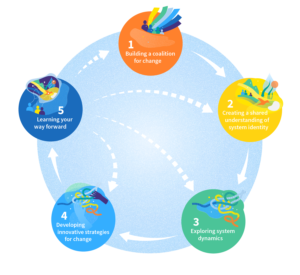The Wayfinder Guide
 The Wayfinder process consists of five phases, which you work through iteratively. Starting by building a
Coalition for change that can lead the process forward, you move on to create a shared understanding of the identity of your system, explore
system dynamics, develop
strategies for change, and implement these through a learning-by-doing approach that will enable you to collectively ‘learn your way forward’ towards a more sustainable future.
The Wayfinder process consists of five phases, which you work through iteratively. Starting by building a
Coalition for change that can lead the process forward, you move on to create a shared understanding of the identity of your system, explore
system dynamics, develop
strategies for change, and implement these through a learning-by-doing approach that will enable you to collectively ‘learn your way forward’ towards a more sustainable future.
This platform will guide you on your Wayfinder journey. It provides you with an accessible summary of the frontier in resilience and sustainability science, together with set of illustrative cases, activity sheets and discussion guides that will be useful along the way. Below you will find an overview of the 5 phases, 15 modules and 40 work cards that forms the Wayfinder process.